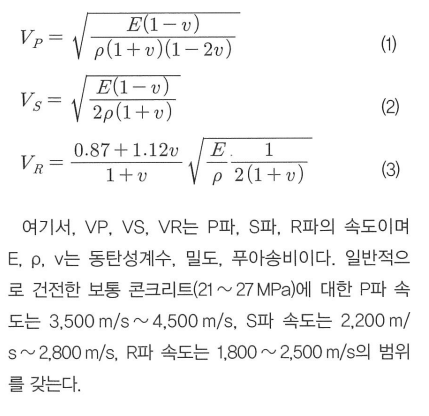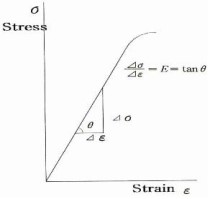탄성계수
Conclusion
동탄성계수는 비파괴시험법으로 얻는 탄성 성질이다.
탄성계수는 압축시험을 통해 측정하며, 재료 고유의 강성(stiffness)을 나타내는 탄성 성질을 뜻한다.
1. Dynamic vs Static modulus of elasticity
-동탄성계수 (dynamic modulus) : 초음파 전파속도를 통해 측정
-정탄성계수 (static elastic stiffness, young’s modulus) : 압축 시험을 통해 측정
시료의 강도가 커질수록 동탄성계수와 정탄성계수 비율 $E_D/E_S$ 이 함께 커지는 경향이 있으며, 일반적으로 동탄성계수가 정탄성계수보다 높게 평가된다.
동탄성계수 (dynamic modulus)
(1) 동탄성계수
콘크리트의 정탄성계수 측정은 실험자의 숙려도나 콘크리트 재료의 불균질성으로 시험체간 오차가 비교적 큰 단점이 있다. 초음파법, 탄성파법, 혹은 공명진동 등의 비파괴시험법을 통해 동탄성계수를 측정할 수 있다.
초음파 종류별 실험식은 다음과 같다.

*회복탄성계수 (Resilient modulus) 는 동탄성계수의 일종으로, 지반재료에서 반복적 하중에 대한 응력-변형률의 관계를 나타낸 것이다.
Resilient Modulus (Mr) is a fundamental material property used to characterize unbound pavement materials. It is a measure of material stiffness and provides a mean to analyze stiffness of materials under different conditions, such as moisture, density and stress level. Beside, the dynamic modulus (E), is one of the most critical parameters for the Mechanistic Empirical Pavement Design Guide (MEPDG), which is used for flexible pavement design. The dynamic modulus represents the stiffness of the asphalt material when tested in a compressive-type, repeated load test. The dynamic modulus is one of the key parameters used to evaluate both rutting and fatigue cracking distresses in the MEPDG.
(2) 정탄성계수
응력-변형도의 비율로 정의한다. young’s modulus 라고도 한다.

2. Strength vs Stiffness
구조설계 시, 강도와 강성을 고려하여 설계한다. 특정한 크기의 힘이 가해졌을 때 부서지느냐, 휘어지느냐, 아니면 형태를 유지하느냐 확인해야 한다.
부서지는 가에 대한 설계는 강도 (strength), 휘어지는 가에 대한 설계는 강성 (rigidity) 이다.
결국에는 강도, 강성이라는 조건을 모두 만족해야한다. 일반적으로 재료의 강성 > 강도 인 경우가 대부분이다.
3. Stiffness, young’s modulus
강성은 수직강성k, 비틀림강성kt, 굽힘강성EI로 나눌 수 있다.
탄성계수E 는 강성을 수치로 표현한 값이다.
탄성계수는 보의 처짐과 기둥의 좌굴 같은 부재의 변형계산에 사용한다.
Reference
[1] https://scienceon.kisti.re.kr/srch/selectPORSrchArticle.do?cn=JAKO200010102441890&dbt=NART
[2] http://www.koreascience.kr/article/JAKO201620136946924.pdf
[3] https://airhand.tistory.com/862

Leave a comment